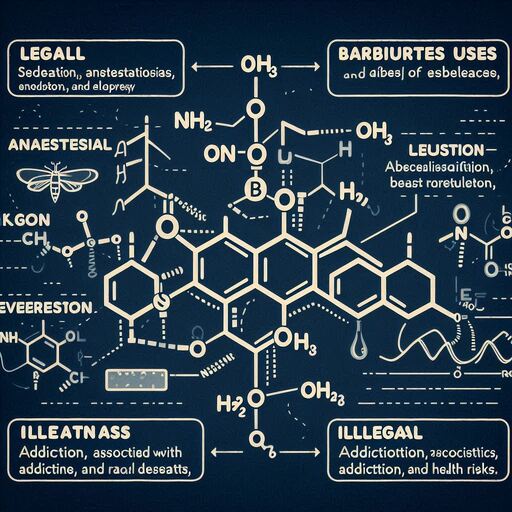The Legal and Illegal Uses of Barbiturates
The Legal and Illegal Uses of Barbiturates
Barbiturates, once staple pharmaceuticals in medicine cabinets, have a rich history that intersects both therapeutic and illicit uses. These drugs, derived from barbituric acid, were synthesized first in the late 19th century and found widespread application throughout the 20th century. They function as central nervous system depressants and were originally prescribed for a range of conditions including insomnia, anxiety, and seizure disorders. However, due to their high risk of dependency and the narrow therapeutic window—making overdoses likely—their use has diminished, supplanted largely by safer alternatives like benzodiazepines. This article provides a comprehensive overview of the legal and illegal uses of barbiturates, highlighting their impact on medical practice and public health.
The Legal and Illegal Uses of Barbiturates
Legal Uses of Barbiturates: The Early Years
Barbiturates were first introduced to the medical community in 1903 with barbital. Their use expanded with the development of phenobarbital in 1912, which quickly became a cornerstone for treating epilepsy and was later listed on the World Health Organization’s List of Essential Medicines. During the mid-20th century, various barbiturates were used to treat anxiety, insomnia, and to induce anesthesia. Their popularity in psychiatric settings was due to their effectiveness in reducing anxiety and inducing sleep, properties that were highly valued in over-the-counter and prescription medications.
The Legal and Illegal Uses of Barbiturates
Doctors valued barbiturates for their potent effects, prescribing them widely for sedative and hypnotic purposes. In hospital settings, thiopental, a barbiturate derivative, became known as “truth serum” and was used in psychotherapy and as an anesthetic. The legal use of barbiturates was largely governed by their perceived medical benefits, despite the growing awareness of their potential for abuse and overdose.
The Decline of Medical Use
By the 1970s, the risks associated with barbiturate use became more apparent. The margin between a therapeutic and toxic dose was too narrow, leading to a high rate of overdoses, some fatal. The dependency potential was another significant issue; withdrawal symptoms could be severe and, in some cases, life-threatening. The development of benzodiazepines, which had a wider therapeutic index and lower dependency risk, led to a decrease in barbiturate prescriptions. Over time, regulatory measures tightened around barbiturates, with many countries relegating them to controlled substance status, prescribing them only when absolutely necessary, such as in severe cases of epilepsy or for euthanasia in veterinary use.
Illegal Uses and Recreational Appeal
The Legal and Illegal Uses of Barbiturates
Despite their decline in medical use, barbiturates found a niche in the recreational drug scene. The sensation of relaxation, euphoria, and lowered inhibitions made barbiturates popular in certain circles. However, the recreational use of barbiturates is fraught with danger. Illegal distribution and use have led to numerous cases of poisoning, prolonged addiction, and even death.
Barbiturates are particularly dangerous because of their high overdose potential. The difference between a dose that produces a desirable sedative effect and one that could be lethal is very small. In the illegal market, barbiturates are often sold under various street names like “barbs,” “reds,” and “yellow jackets,” and are used in combination with other substances, which further increases the risk of adverse effects or fatal outcomes.
Regulatory Actions and Legal Restrictions
The Legal and Illegal Uses of Barbiturates
Globally, governments have taken steps to curb the prescribing and distribution of barbiturates. In the United States, barbiturates are classified as Schedule II, III, or IV drugs under the Controlled Substances Act, depending on their potential for abuse and dependence. This classification mandates strict regulations on prescribing, storage, and record-keeping by medical professionals.
Legal production now is primarily aimed at meeting the needs of ongoing but limited clinical applications, such as in the treatment of chronic seizure disorders or in execution protocols, as some states in the U.S. use barbiturates like pentobarbital for lethal injections. The regulatory landscape aims to balance the medical necessity against the potential for abuse.
Moving Forward: Education and Awareness
The story of barbiturates is a cautionary tale in pharmacology and public health. It underscores the need for vigilance in the prescription and use of psychoactive substances. Education for both medical professionals and the public is crucial to reducing the risks associated with barbiturate use. Programs that highlight the dangers of misuse, the signs of addiction, and the importance of proper medication management can help mitigate the negative impacts.
The Legal and Illegal Uses of Barbiturates
Additionally, ongoing research into safer alternatives for treating conditions like epilepsy, anxiety, and insomnia continues to be vital. As the medical community moves forward, the lessons learned from the rise and fall of barbiturates remain a guiding light in the quest to balance therapeutic efficacy with safety.
In conclusion, while the era of widespread barbiturate use in medicine has largely passed, these drugs remain a potent reminder of the need for careful drug regulation and oversight. Understanding both their legal and illegal uses helps inform better practices in prescribing habits and public health policies, ensuring that the benefits of such powerful drugs do not come at an unacceptable cost.

The Legal and Illegal Uses of Barbiturates